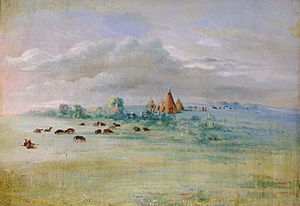Cloud Man facts for kids
Quick facts for kids
Cloud Man
|
|
|---|---|
|
Maḣpiya Wic̣aṡṭa
|
|
| Mdewakanton Dakota chief | |
| Personal details | |
| Born | c. 1780 Near Mendota, Minnesota |
| Died | 1862/1863 Pike Island, Minnesota |
Cloud Man (also known as Maḣpiya Wic̣aṡṭa in the Dakota language) was an important Dakota chief. He was born around 1780 and passed away in 1862 or 1863. Cloud Man's parents were French and Mdewakanton Dakota. He started a farming village called Ḣeyate Otuŋwe near Bde Maka Ska in 1829. This happened after he survived being stuck in a big snowstorm for three days.
Even though some white settlers saw his village as a way for Dakota people to adopt European customs, the community kept their strong Dakota traditions. The village was later left in 1839. Cloud Man and his group moved to the Minnesota River area. During the Dakota War of 1862, Cloud Man was held at Pike Island, where he died.
Contents
Cloud Man's Early Life
Cloud Man was born around 1780. He was part of the Mdewakanton Dakota group. His village was about 8 miles from Mendota, Minnesota, near the Minnesota River. His father was French, and his mother was Mdewakanton. She was said to be the granddaughter of a chief who met Louis Hennepin. Hennepin was an explorer who visited New France in the late 1670s and early 1680s.
An Indian agent named Lawrence Taliaferro once suggested that Cloud Man try a different way of life. He wanted Cloud Man to settle down and farm instead of living a nomadic (traveling) lifestyle.
Surviving a Snowstorm
One time, Cloud Man and his group were on a hunting trip. They were near the Missouri River when a huge snowstorm hit. They had to wrap themselves in blankets and lie on the ground. They waited for almost three days for the snow to stop. Each person was buried separately under snowdrifts. They had only a little dried buffalo meat to eat.
Cloud Man later told a missionary named Samuel W. Pond about this experience. He said he would dig to the surface of the snow to find his friends. But each time, more snow and strong winds would greet him. When the storm finally ended, he called out for his group. Everyone had survived, and they were close to another Indian camp.
During the storm, Cloud Man thought a lot about Taliaferro's idea. After returning home, he visited Taliaferro at Fort Snelling. He asked for advice on how to start a farming community. Leaders at the fort liked his plan. They gave him tools and seeds to help. Cloud Man then went back to his village. He convinced several families to move with him to the banks of Bde Maka Ska.
Ḣeyate Otuŋwe: A New Village

Cloud Man started the farming village called Ḣeyate Otuŋwe in August 1829. It was located on the shores of Bde Maka Ska. Today, this area is where Lakewood Cemetery is in Minneapolis. Cloud Man was elected chief of this new community. He was about 35 years old. The village began to grow crops like corn and potatoes.
Taliaferro and other white settlers, like missionaries Samuel W. Pond and Gideon H. Pond, saw Ḣeyate Otuŋwe as an experiment. They thought it was a way for the Dakota people to live a "civilized life." Taliaferro even called it "my little Colony of Sioux agriculturalists."
However, historian Katherine Beane suggests something different. She believes that Cloud Man saw this move as a step towards independence. At that time, traditional Dakota ways of life were being challenged by white settlers. Beane says that Cloud Man never planned to stop being a Dakota man. Changing how they got food did not make the people of this village any less Dakota.
The people of Ḣeyate Otuŋwe shared some of their corn with other Dakota villages. Taliaferro did not like this. In September 1835, he gave a speech telling them to stop. He said it was not good for their own interests, but they did not stop. Cloud Man also traveled to Washington, D.C., in 1837. He was part of a Dakota group. He spoke to leaders of the Sauk and Meskwaki tribes about recent fighting between them.
By 1839, the village had 207 people. There were 54 women, 72 men, and 81 children. That same year, Ḣeyate Otuŋwe was abandoned. Cloud Man was worried about attacks from nearby Ojibwe people after a recent war. Cloud Man and his group moved to the shores of the Minnesota River, near Bloomington, Minnesota.
In 1851, Cloud Man and his group moved again. They went up the Minnesota River to near Yellow Medicine County. There, they joined another farming community called the Hazelwood Republic.
Later Life and Legacy
During the Dakota War of 1862, Cloud Man was held at a camp on Pike Island. He passed away there during the winter of 1862–1863. The place where he died and was buried was close to where he was born.
In 2019, the Bde Maka Ska Public Art Project was finished. This project honors the history of Ḣeyate Otuŋwe and its people.

